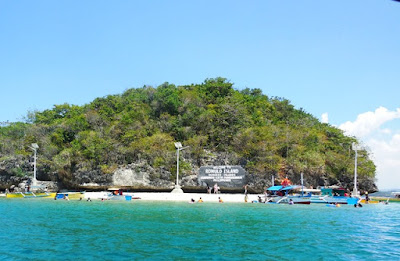The Hundred Islands National Park (Pangasinan: Kapulo-puloan or Taytay-Bakes) is a national park in the Philippines. The protected area is located in the city of Alaminos, in the province of Pangasinan in northern Philippines. The islands, totaling 124 at low tide and 123 at high tide, are scattered in Lingayen Gulf covering an area of 16.76 square kilometer (6.47 sq mi).
The Lucap wharf in Alaminos, the entrance to the National Park, is about 240 kilometres (150 mi) north of Manila, the capital of the Philippines.The national park was created by Presidential Proclamation No. 667, covering an area of 16.76 square kilometres (6.47 sq mi) and signed by President Manuel L. Quezon on January 18, 1940, for the benefit and enjoyment of the people of the Philippines and known as the Hundred Islands National Park (HINP).
On 1982 the national park including Lucap Bay and its foreshore areas, beginning from Sitio Telbang to the east to Sitio Recudo to the west, were declared as a Tourist Zone and Marine Reserve under the control and administration of the PTA. By President Gloria Macapagal-Arroyo on 2005, transferred the administration, management, maintenance and operation of the whole Hundred Islands National Park (HINP), including all the activities, facilities and improvements thereafter, from the Philippine Tourism Authority (PTA) to the city government of Alaminos, Pangasinan.
This National Park covers a land area of 1,884 hectares with 123 islands. However, there are only 4 major developed islands: Governors Island, Quezon Island, Marcos Island and Children's Island.
Governor’s Island has a viewing deck, and even a small house that can be rented.
View of the other islands from the Governor island.
Some of the islands as seen from the viewing point on Governor Island.
Children's Island lives up to its name as its shallow waters are very suitable for small children.
Quezon Island can be considered as Hundred Islands’ activity center because among its many islands, this jam-packed bliss is the only place where you’ll see a lot different fun activities happening.
Marcos Island’s fantastic beach and natural swimming pool is a great combo for swimming enthusiasts.
Imelda Cave on Marcos Island: A cathedral-shaped nature cave, it has two chambers, with the outer chamber accessible via a submerged opening from one side of the island and from an open ceiling which can also be reached by a 30-m trail from the beach area. One of the favorite things to do here is to dive from the tip of the wooden stairs and into the water. The cave which can be reached by swimming, kayaking or rafting is a corner of serene beauty on which one can just lay back and enjoy the quiet atmosphere.
This natural swimming pool inside the Imelda Cave is protected from the sunlight by the tunnel that houses it. Going down its wooden stairs won’t be much of an effort as it’s not very high. You would immediately feel the coolness inside this cave just half-way of entering it. Make sure to bring your life jacket if you’re not a good swimmer yet because every corner of this swimming pool is very deep.
Other Islands good for snorkling and just lying on its beach.
Old Scout Island:
Lopez Island:
Macapagal Island: (good for snorkling)
Romulo Island:
-wikipedia, wonderingwanderer


























































